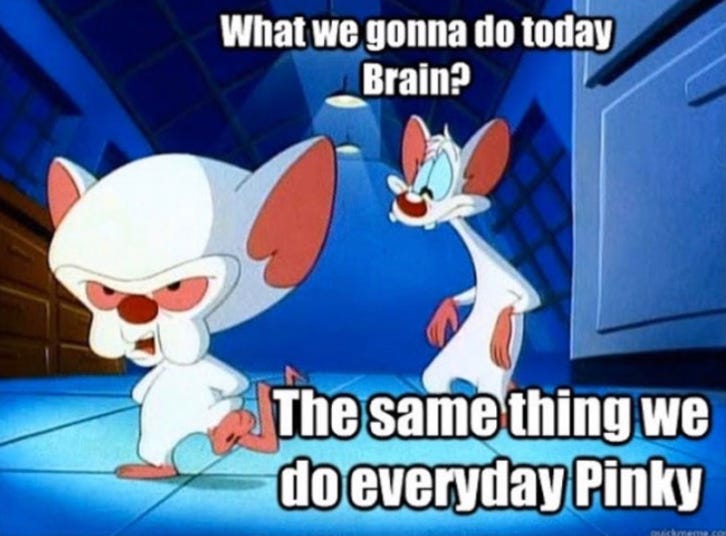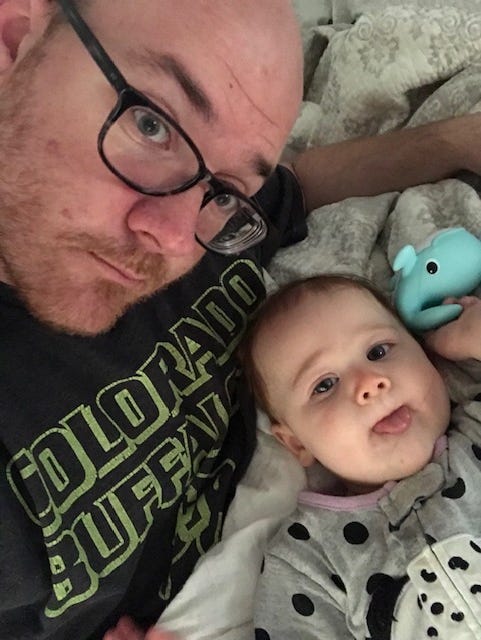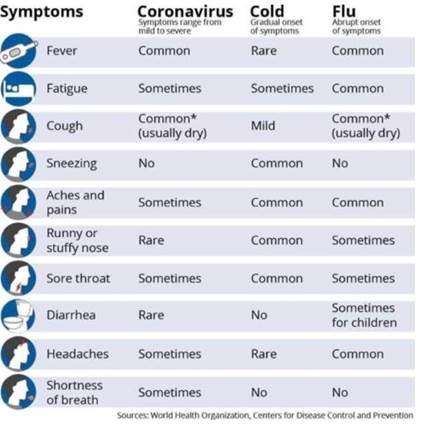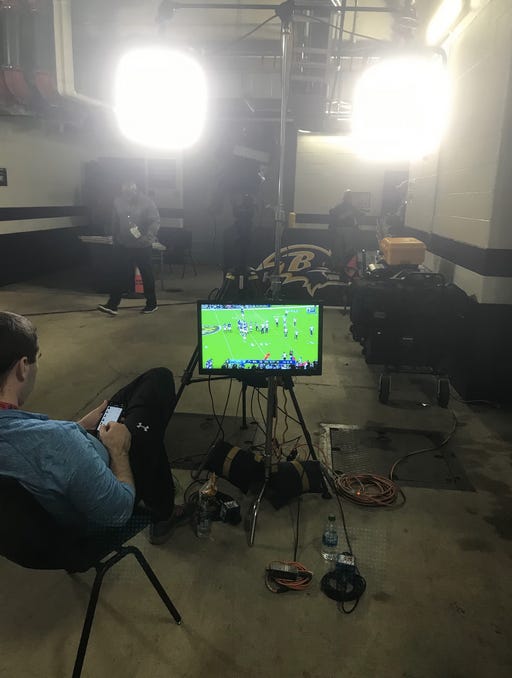Pinky and the Brain; So much to say; We’re doing fine, all things considered; The stories don’t write themselves; Mrs. Kelly’s Monster; Write what happened; Link dump; The Jordan doc and NFL Draft
Draft No. 4: Coronavirus Edition No. 2
1) What are we gonna do today, Brain? The same thing we do everyday, Pinky… Try to take care of the child.
When we last spoke, I wrote that we were on the eve of full-blown quarantine mode. Looking back, this was right before the rest of the country figured it out.
At the time, we didn’t know what to expect. About six weeks later, at least for me, it feels like this…

And this...

And this… (These Dave Matthews Band lyrics include “I'm stuck inside,” “Got central heating and I'm alright,” and “Open up my head and let me out.”)
I’m pretty sure Dave Matthews did not have a stay-at-home pandemic in mind when he wrote “So Much To Say,” but the song is so appropriate today.
Here in Maryland, our governor has done a great job communicating, keeping people updated, securing 500,000 COVID-19 tests from South Korea, and NOT suggesting you eat a Tide Pod to treat the coronavirus.
The curve has been flattened, and I truly believe that we’re just going to have to get used to living differently for probably the next year – like wearing masks out in public places.
Signs point to the virus not disappearing for some time. In Australia (opposite season to us), it’s there. In places like Singapore (which stomped out the virus early), it returned once people were let back out into the wild.
But we also can’t stay at home forever. Now that the worry about overwhelming our health care system (at least for now) has been reduced in a few places, there’s probably a middle ground of “social distancing” to be found eventually.
2) I’ve written a ton about the ‘pandemic economy’ over the last few weeks.
There’s more than a dozen links below. Here’s a sample from one, on March 17, for Stansberry Research:
The bars are empty on St. Patrick's Day...
That's the scene here in Maryland, where Gov. Larry Hogan ordered all bars, restaurants, gyms, and movie theaters to close at 5 p.m. yesterday.
Over the weekend, a bunch of images of college kids drinking together on social media seemed to have sealed the deal. Hogan said of the decision at a press conference...
The good news is that most people who get COVID-19 aren't going to get really ill...
It's just that vulnerable population of older adults and people with compromised systems or underlying health conditions, that the mortality rate is very high.
We're trying to keep those people from getting infected by all the other people, like the ones who were crowded into bars all weekend.
For a person with some Irish blood, it's tough... Drinking Guinness at home out of the bottle doesn't bring the same joy as it does sipping it fresh from a draft.
But of course, we have greater concerns today...
Fortunately, Jamie, Molly and I have been healthy through this whole COVID-19 episode… We’re doing fine, all things considered.
But I’d be ignoring reality if I said there haven’t been challenges, mainly with both of us balancing working from home every day while taking care of our dear 8-month-old. She’s pretty mobile now and also knows when we’re gone, so, you know…
In truth, Jamie does too much of the work around the house. I’d be lost and probably living in a cardboard box on the street without her. But we’re hanging in there.
I’ve been writing a ton about what’s been going on over the last month (see below for links)… and on deadline days (about three days per week) time to focus is a need, not a want. These stories don’t write themselves, after all.
At the same time, Jamie’s busy running point on a lot of different projects for the Johns Hopkins neurosurgery department. Most of the doctors, faculty, and residents have been thrust into COVID duty at the hospital with everyone else.
We’re not alone, of course. These last two or so months have been so hard for so many people in similar and different ways. But I’m here (mostly) to talk about writing.
3) Introducing, Mrs. Kelly’s Monster.
Along the lines of neurosurgeons, allow me to introduce to you one of the stories that inspired me to pursue journalism for a job or at least a passion back in my undergrad days at Penn State... Here it is… Mrs. Kelly’s Monster.
Now, there’s a lot of weird coincidences at work here…
First, I had no clue a decade ago that I’d up married to someone who works with actual brain surgeons all day long…
Second, the story, written by Jon Franklin, originally appeared in the Baltimore Sun. When I first read it in a class titled “Literary Journalism,” (I still have our textbook), I also didn’t know I’d end up in Baltimore.
But I did have a clue that the story Franklin wrote was amazing.
In brief, it’s the story of a neurosurgeon operating on a tumor, the monster. A simple idea. But it’s told in a totally fascinating, concise, detailed, compelling and award-winning way.
The best thing I can say about this story is the tension grows and intensifies with each line, each word.
I remember reading it for the first time and feeling my heart race, as Franklin takes you through the brain of the patient, Mrs. Kelly, and the doctor trying to save her, Dr. Ducker. It’s a feature writing clinic.
On the television screen the tweezer instrument presses on, following the artery toward the brainstem. Gently, gently, gently, gently it pushes aside the gray coils. For a moment the optic nerve appears in the background, then vanishes.
The going is even slower now. Dr. Ducker is reaching all the way into the center of the brain and his instruments are the length of chopsticks. The danger mounts because, here, many of the vessels feed the pilot light.
The heartbeat goes pop, pop, pop, 70 beats a minute.
The story humanizes the entire concept of brain surgery. In other words, it shows the realness of the people involved, which is a key thing to do when you’re writing anything.
At the end of the story, I learned in the footnote of our class textbook that it won the first ever Pulitzer Prize for feature writing in 1979. That seemed right.
If you are interested in great writing, I suggest you give it a read.
And if you want to get really nerdy about it, in an interview with Neiman Storyboard a few years ago (Neiman’s a great resource for writers), Franklin explained nearly every decision that he made while writing, and basically annotated every line to show his thought process.
It’s fascinating and you’ll learn a lot.
4) This Is His Lane
Fast forward to today. In the middle of last year, I worked on a feature story on Dr. Joseph Sakran, an emergency room trauma surgeon at Johns Hopkins.
I will admit I had Mrs. Kelly’s Monster on my mind a little bit when I was working on this story, for better or worse. I don’t think it will be nominated for a Pulitzer, but Dr. Sakran’s tale sure is compelling and was one of the features in Baltimore magazine’s most recent Top Doctors issue.
In brief, Sakran was shot in the throat as a teenager, almost died, then decided to become a trauma surgeon, inspired by the doctors who saved his life. He’s become a nationally respected surgeon at one of the country’s busiest ER's and now he’s crusading against gun violence, as a leading advocate in Washington, D.C.
This is one story where I tried, as a writer, to just get out of the way. My friend Sirage Yassin (one of those who receives this newsletter unsolicited; Hi, bud) once shared some simple advice with me way back when, when I was feeling pressure writing a story that I don’t even remember today: “Write what happened.”
That’s always a good idea.
“I’ve said it so many times,” Sakran says, “the worst part of my job is having to go talk to the families of those loved ones and tell them that the child that left that morning is never coming home again.”
He’s done it too often, hundreds of times, which is why he’s currently in the middle of moving to Washington, D.C., a temporary relocation from his home in Brewers Hill, for a yearlong sabbatical as a health policy fellow at the National Academy of Medicine.
Related, one of the saddest stats I’ve seen about the pandemic (outside of the deaths and infections and jobs lost, of course)… is that March 2020 was the first March since 2002 without any school shootings in the U.S.
All it took was for all schools to be closed for it to happen.
4) Pandemic link dump
Here’s links to a bunch of stories I’ve written over the last several weeks, in the Stansberry Digest and DailyWealth newsletters.
These three include some bigger-picture ideas…
On prevention, the all-too-forgotten most valuable thing in the world: The Best Way to Save $2 Trillion, March 30.
On just the strangeness of living in a pandemic: It’s Strange Living in a Pandemic Economy, March 17.
And on when the stock market might bottom (implying it hasn’t happened yet): Bear Markets End When Nobody Is Watching, April 7.
And the rest are more of the daily “first drafts of history” variety.
When Fear Takes Hold, Don’t Overlook These Lucrative Assets, April 18
The ‘Meatless’ Trend That Nobody Expected, April 13
It’s a Crash Mash-Up of 1929, 1987, and 2009, April 6
Take a Breath, Pause, and Consider the Long Term, April 4
When Doctors ‘Redeploy,’ the Money Changes Direction, Too, April 1
The Fed Has a ‘Blank Check’… And Is Not Afraid to Use It, March 28
The Greatest Stocks of All-Time, March 26
Making A List and Checking It Twice, March 25
What Porter Is Doing With $1 Million Today, March 23
The Markets Are Running Like a Pack of Wild Dogs, March 18
Here’s What You Need to Know About the Pandemic Crisis, March 16
What Goes Down Must Come Up?, March 13
This Is Real March Madness, March 12
Panic Triggered the Circuit Breakers, March 9
5) Sports (kind of) on TV.
With the Tiger King phenomenon now thankfully behind us, it seems the most talked-about thing streaming today is the new “Jordan documentary,” a.k.a. The Last Dance. I’m looking forward to watching the next episodes tonight.
One takeaway from the first two episodes: The number of interviews included, including one with Chicago Bulls fan Barack Obama, is really impressive.
Finally, the NFL draft happened over the last few days. I’ve said before the draft is essentially a glorified business conference broadcast on TV, but in an era where literally nothing new is on except for the anxiety-provoking news, it was a welcome respite.
How many classic games can one watch?
So not surprising that a record 15-plus million people watched the first night of the draft, which I wrote about here for Baltimore magazine. It was different than usual, since all the team officials and players were at their own houses rather than gathered in one spot.
The Ravens had an incredibly good draft, and it went off without a “glitch.” #DadJoke
That does it for now. Hope you’re all doing well. Stay strong.
Corey
P.S. If you haven’t gotten the last few of these e-mails from me, that’s because I thought it better to not overwhelm your inbox and send these only to people who signed up by choice (except my immediate family, so long as they haven’t disowned me.)
But, it turns out, I’m only sending these notes about once per month, which is less frequent than I thought I would. So I’ve added a few of you back to my e-mail list since last month’s issue.
If you wish to unsubscribe, feel free, of course, but like I said at the start of the year, everyone receiving this newsletter has brought something good and valuable to my life either professionally, personally, or both (whether you know it or not). So thank you.







